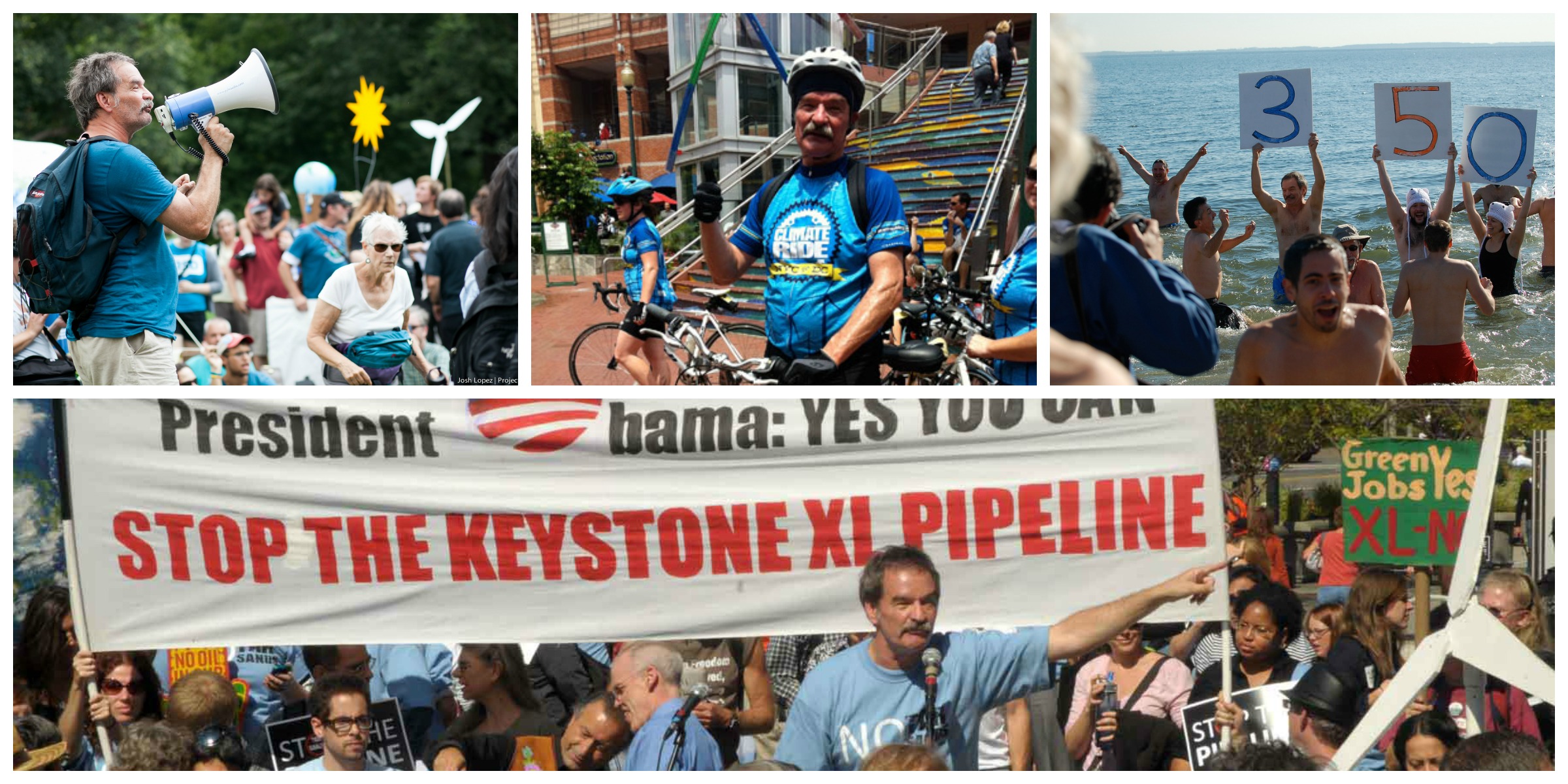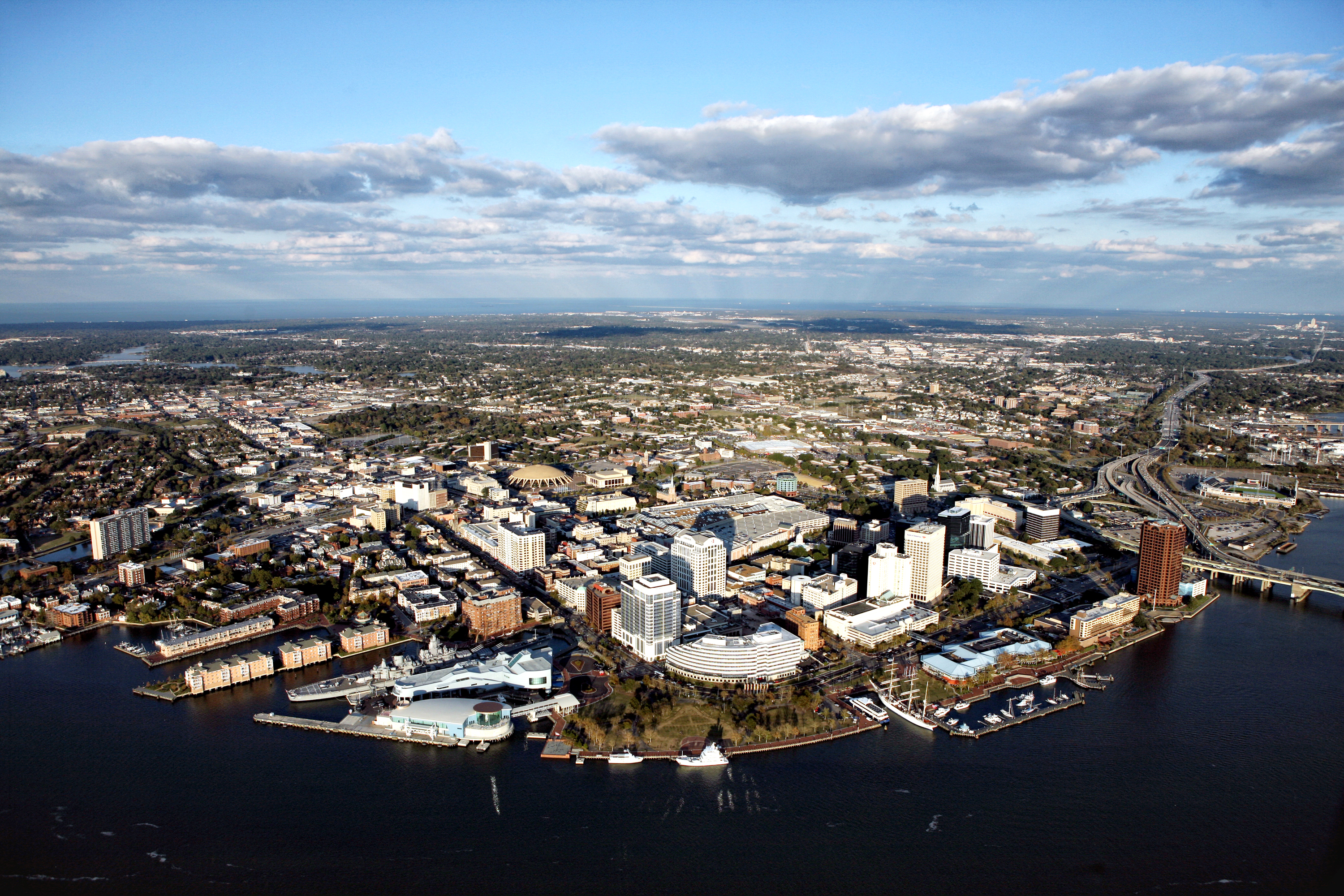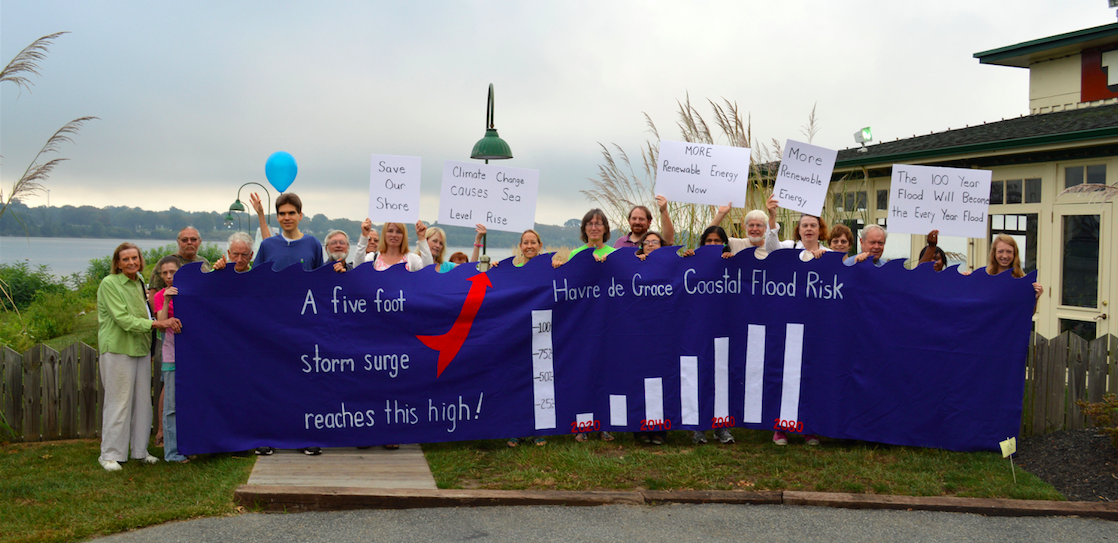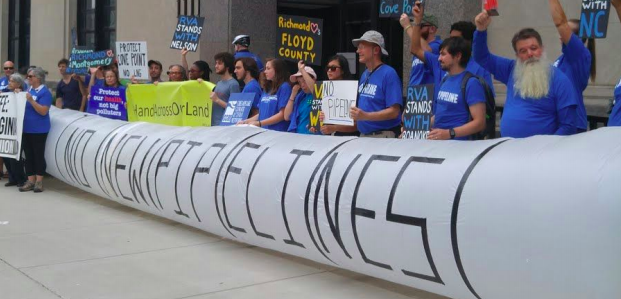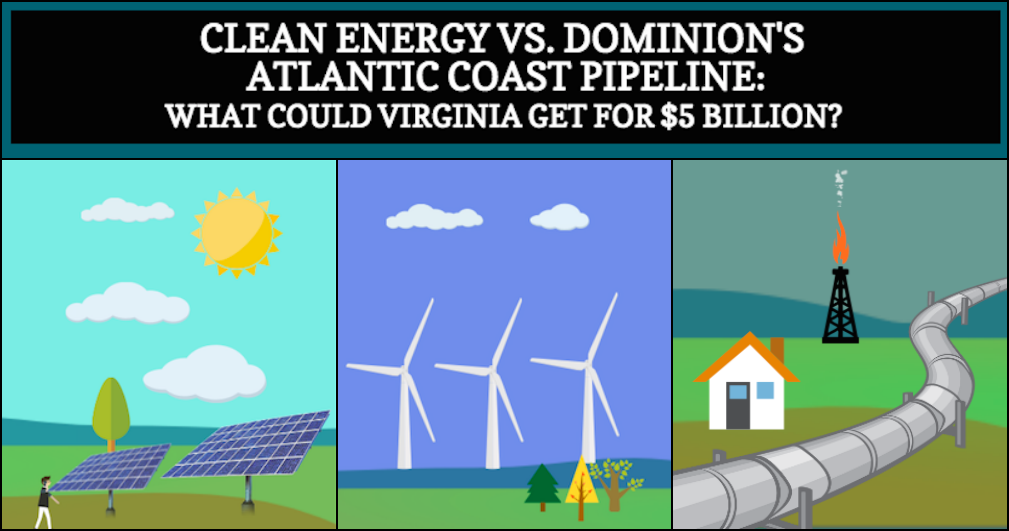In the final two week of November, the city of Fredericksburg and the town of Leesburg both passed resolutions in support of the Virginia Coastal Protection Act. The votes came on the heels of a number of cities in the Hampton Roads, including Hampton and Virginia Beach, that have also voted to support the bipartisan legislation to allow Virginia to join the Regional Greenhouse Gas Initiative (RGGI).
RGGI is a cooperative effort among nine east state from Maine to Maryland that caps and reduces their emissions from power plants. Under RGGI, power plants in participating states purchase allowances for every ton of carbon pollution that they emit. Virginia could receive as much as $209 million annually from the proceeds from the the allowances, which would be directed towards climate-related flooding mitigation, energy efficiency, renewable, and economic development in southwestern Virginia.
With the General Assembly session just around the corner, momentum is building once again for the Virginia Coastal Protection Act. Last year, the bill narrowly failed to make its way out of the Senate Agriculture, Conservation, and Natural Resources Committee. The bipartisan patrons of last year’s bill, Del. Ron Villanueva (R-Virginia Beach) and Sen. Donald McEachin (D-Richmond), are expected to reintroduce the legislation in the coming weeks.
This time around we’ve built an even broader and more diverse coalition of supporters. Businesses large and small, as well as, housing advocates and social justice organizations are all on board. Scientists are saying that 2015 is well on its way to being the warmest year on record, and we need solutions for coastal Virginia now.
As we approach General Assembly session in January, we will need your help to pass the Virginia Coastal Protection Act. You can find out how to get involved by emailing me at Charlie@chesapeakeclimate.org.
Letter from the Director: Thank you, Ted
Dear CCANers,
Chances are if you know CCAN, you know our National Campaign Coordinator Ted Glick. If you’re a long-time CCAN activist, if you’ve joined one of our annual “polar bear plunges,” protested the fracked gas export facility at Cove Point, walked 100 miles in the summer heat to stop Keystone XL, or picketed outside the Federal Energy Regulatory Commission, you’ve likely met Ted and been inspired by him.
This month, after nearly ten years of service to CCAN, Ted is retiring. Well, retiring is not the right word. He’s stepping back to do more writing and spend more time with his lovely wife Jane and get more involved in local climate fights up in New Jersey where they live. I don’t think Ted will ever slow down. He just won’t be in the official employ of CCAN anymore.
We will miss Ted tremendously. He brought to CCAN a streak of 1960s idealism and a passion for creative street protests. He got peacefully arrested multiple times while advancing CCAN causes. He fasted almost as many times, his last being an 18-day water-only fast outside of the Federal Energy Regulatory Commission last month in DC. He also illegally occupied a ledge in protest at the National Oceanic and Atmospheric Administration. And he wrote and shared a lot of poems. Ted can stand up to tough cops and deaf politicians one moment, then recite a poem the next about the glorious mockingbird he heard during his morning walk that day.
When Ted came to work at CCAN in 2006, there was no national “fossil fuel resistance.” Now Keystone looks finished, coal plants are getting shut down, and fracked gas is finding determined opposition everywhere. Ted played a big role in making that sea change happen.
So, to my friend and colleague and mentor, I say: Thank you, Ted. Thanks for fighting with everything you have against the greatest threat human beings have ever faced. You have made a difference.

Mike Tidwell
Court win increases oil train transparency, but it’s not enough
At the end of the summer, Baltimore Circuit Court Judge Lawrence Fletcher-Hill ruled in favor of safe cities and healthy communities, stating that rail companies must disclose the routes of dangerous oil trains the public. His ruling affirmed that communities have a right to know if dangerous, explosive trains run through their neighborhoods. This lawsuit victory is one part of a growing national movement to stop dangerous oil trains from rolling through communities and spreading a network of dirty fossil fuels. Now, we have a clearer picture of where oil trains actually move throughout Maryland, and what we can do next to stop them!
Oil trains in Maryland enter from states that border us to the north, coming from major oil hubs like Newark and Philadelphia. Following Pulaski Highway (Rte. 40), oil trains roll past Havre de Grace and Aberdeen, and cross Herring Run into Baltimore. Trains then move through the heart of the city, following 26th street into Charles Village, turning south at Jones Falls. At that point, trains enter the Howard Street tunnel, passing directly under the Maryland Institute College of Art, the Department of Health and Mental Hygiene, Maryland General Hospital and the University of Maryland Medical Center, Lexington Market, and the Baltimore Convention Center. Trains exit the tunnel next to a Raven’s stadium parking lot, and wrap around the stadium as it travels south crossing Gwynns Falls, through Westport and then Brooklyn to a shipping terminal on the Fairfield peninsula.

Oil also comes in from the west, directly from Pittsburgh. Trains travel on the CSX railroad line through Cumberland, passing Harpers Ferry, and through Frederick County, where it meets the headwaters of the Patapsco River. It then follows the Patapsco through Monrovia to Ellicot City, where it enters the City through Morrell Park and Mount Winans, where it meets up with the northern rail line to the shipping terminal in Fairfield. Through research, we found out that this puts over 165,000 people in the blast zone in Baltimore. In Baltimore city, these trains predominately run through communities of color and low-income communities, disproportionately putting these people at risk, and is an environmental injustice.
In the past two years, over 100 million gallons of crude oil have been offloaded from oil trains in Baltimore. These numbers come from the State’s Oil Control Program, which is a regulatory agency that requires oil and rail companies to disclose how much oil comes through the state. But here’s the catch: the OCP requires oil companies to report only when over 1 million gallons of crude oil are unloaded from a train in Maryland. This means that if a train is carrying less than 1 million gallons of crude oil (about 35 tankers on a single train), it can be unloaded and stored in Maryland with no need to report this information to the public. It also means that oil trains passing through the state, on their way to oil hubs in the Northeast, for example, go unreported. The real amount of oil that travels through Baltimore and Maryland is still unknown, although it’s almost certain that it’s much, much more than what’s being reported.

The truth is, oil companies are still keeping the public in the dark. Because of this, CCAN will continue to push for public transparency and education surrounding oil trains, and work to make it as hard as possible for oil companies to ship their dirty, explosive fracked oil through the state. Ultimately, oil trains shouldn’t exist, the dangers are too high, and a federal ban should be instituted immediately. However, in Baltimore, we’re calling on the city council to pass a 4 year moratorium on new crude oil shipping terminals, to stop the alarming increase of oil trains in Baltimore. And as we continue into the new year, CCAN will work at the state and national level to make it harder for companies to ship out crude oil.
We know to stop runaway climate change we have to keep fossil fuels in the ground. It turns out, one key way to do this is stopping the transport of fossil fuels, making our fight against oil trains just as important. An excellent report that just came out from Oil Change International proves that point. Our recent legal victory is a great step forward in the fight against fracked oil, but it’s not enough.
If you are interested in volunteering with CCAN to stop explosive oil trains in our region, contact Jon Kenney at jon@chesapeakeclimate.org or 240-396-1985.
New Health Research Underlines Why We Fight Fracking
At CCAN, we’re fighting to keep fracking wells out of our communities — and to stop new pipelines, compressor stations, and export facilities that drive demand for new fracking — because we know that this extreme form of fossil fuel extraction is a disaster for our climate.
But that’s certainly not the only reason we fight fracking. A comprehensive review of scientific studies released this fall underlines how fracking and its associated infrastructure also pose an immediate threat to our health.
In October, Concerned Health Professionals of New York and Physicians for Social Responsibility teamed up to release a compendium and associated report summarizing more than 500 peer-reviewed scientific studies, along with other important medical, government and media findings on fracking available through July 31, 2015. The compendium, now in its third edition, finds overwhelming evidence that fracking poses poses significant and unavoidable risks to public health, air and water quality, birth and infant health, worker safety, the environment, our climate, and more.
I’d sum up the overarching conclusion of the report as follows: Keeping fracking out of our communities is the only proven way to protect our families, children, and workers from harm. The report’s authors put it in slightly more technical terms:
Emerging data from a rapidly expanding body of evidence continue to reveal a plethora of recurring problems and harms that cannot be averted or cannot be sufficiently averted through regulatory frameworks. In the words of esteemed pediatrician Jerome Paulson, MD, there is ‘no evidence that…fracking can operate without risks to human health. … Any claims of safety are based on wishful thinking.’
This conclusion — that regulations are simply not capable of preventing harm — is one that we must keep repeating in Maryland. We won a huge, grassroots-powered victory this spring, when Governor Larry Hogan allowed a two-year fracking moratorium to become law (without his signature). But that same legislation, which prevents any drilling activity through October 2017, also requires Governor Hogan’s administration to finalize regulations for fracking by October 2016. Those regulations would go into effect when the moratorium lifts in October 2017.
Every passing study — like the Johns Hopkins study released this October showing a 40 percent increase in risk of preterm birth among mothers living near active fracking sites in Pennsylvania — underlines why we can’t let up now. As health professionals conclude that regulations are simply not capable of preventing harm, the evidence of harm just keeps growing. We have a hard deadline of October 2017 to ensure regulations stay out of play and that fracking stays out of Maryland.
That’s why CCAN has been hard at work this summer and fall building the movement we need to keep fracking out of Maryland permanently. That’s why, ultimately, Governor Hogan and our state lawmakers must follow the lead of Governor Andrew Cuomo in New York and put an outright ban on fracking. And why local elected leaders in counties and cities that sit atop known gas basins, from Garrett to Prince George’s, can and should take their own action and pass ordinances to keep fracking out.
As Governor Hogan’s administration weighs the fracking regulations due in October 2016, we know that the Governor himself was informed of the latest research findings. Concerned Health Professionals of Maryland and Chesapeake Physicians for Social Responsibility sent a letter to Governor Hogan summarizing the alarming evidence of harm and calling on him to lead Maryland down a different, safer path:
We cannot sit by silently while Maryland residents are forced to become subjects in a large-scale public health experiment, as has happened in other states. You are uniquely positioned to lead Maryland away from this dangerous and unethical practice and to accelerate the transition to a renewable-energy based economy.
At CCAN, we couldn’t have said it better. Our health and our climate depend on keeping fracking out while speeding up our transition to truly clean energy resources like wind and solar. You can get involved with CCAN on both fronts throughout this fall and winter. We’re gearing up to pass legislation in 2016 to significantly expand Maryland’s renewable electricity standard. By requiring that 25 percent of our electricity come from clean sources by 2020, we can significantly improve Maryland’s air quality while preventing 50 to 110 premature deaths per year and increasing regional economic growth by $458 million to $1 billion annually due to better health outcomes.
Click here to learn how you can help protect our health from fracking. Click here to learn how you can help improve our health with clean energy!
Meet a CCANer: SheéLee Rock
Meet Hampton Roads Activist SheéLee Rock

Your age: 36
Where you live: About 10 years in the Kempsville area of Virginia Beach, VA.
Your profession: Mother of two, Childbirth Educator & Birth Doula. I teach couples how to have awesome birth experiences, and if I’m lucky, they choose me to support them through their labors. I have also supported many women in their goals of breastfeeding. It’s extremely gratifying work!
What are the impacts of climate change that hit closest to home for you? Each time it rains heavily in Hampton Roads we get flash flooding somewhere. It’s a huge safety issue for individuals and for schools responsible for transporting students. How will I make it to a laboring woman in downtown Norfolk during heavy rains? Second to safety is asset damage. Not just my own, but I’m very concerned about the local business owners who may lose their livelihoods by the damage flooding will inevitably cost them.
Why did you decide to get involved in taking action on climate? There are many issues I feel passionately about, including domestic violence prevention and the need for transparency in food labeling. However, when I look at prioritizing the “causes” I’m supporting, it’s just common sense. We cannot argue about anything or advocate any cause, if we are fighting for our lives and homes in a “Hurricane Katrina-type disaster.”
What has inspired you most working with CCAN and/or in your community? Grassroots organizations are, at their core, inspiring. When you witness local, concerned citizens who have a stake in the issue of climate change and coastal flooding volunteering their efforts to make change for the better, it’s hard not to feel that enthusiasm. It’s very motivating. I’ve been serving my community in many ways since a youth involved in Virginia’s 4-H programs. Activism is second nature to me. It’s something my husband and I are instilling in our girls.
What do you hope to see happen in the next year to address the impacts and causes of flooding in Hampton Roads? I’m looking forward to our wonderful state of Virginia getting on board with the Regional Greenhouse Gas Initiative (RGGI). It’s time for them to join the 9 other east coast states in support of the first market-based regulatory program in the United States to reduce greenhouse gas emissions. This twofold program is expected to bring in over $200 million dollars in yearly revenue that will be designated to combat flooding issues and to train coal workers in higher paying renewable energy fields. Wow!! You can’t help but to get excited about that!
What do you like to do when you’re not advocating in your community? My daughters, ages 11 & 2, keep me very busy! I also lead the young women’s youth group at church, enjoy volunteer work, and if there is any time leftover I can be found researching my favorite subjects like holistic nutrition and remedies, natural childbirth and politics.
Who would you high five? I’d like to hi five the nonpartisan and progressive leaders of Connecticut, Delaware, Maine, Maryland, Massachusetts, New Hampshire, New York, Rhode Island, and Vermont who made the wise decision to adopt the Regional Greenhouse Gas Initiative (RGGI) and whose states are already reaping the benefits of their wisdom; and Oprah, because she’s my hero! She’s overcome many serious obstacles in her life and manages to maintain a heart of service and a love for the human connection.
Activists Across Maryland Advocating for Clean Energy
This fall CCAN activists and allies advocated for climate change in their communities and in congregations across the state. From over 85 congregations raising up climate justice from the pulpit, to creative community action highlighting the dangers of sea level rise, to our six-stop “Clean Energy Roadshow” sweeping Maryland this fall, we’re engaging hundreds of new people in our movement to strengthen Maryland’s most important climate policies.
After we renew Maryland’s landmark Greenhouse Gas Reduction Act, our top legislative priority in 2016 will be expanding Maryland’s clean electricity standard. This is the number one way we can drive investment into new solar and wind power, moving our state away from fossil fuels, cleaning up our air, and creating thousands of new jobs in the process. Thanks to all of our volunteers and allies, we’re building great momentum behind this campaign this fall!
Sign up for our upcoming roadshow events in Harford County, Howard County or Baltimore City to get involved.

On the weekend of September 27th over 87 congregations participated in a joint initiative between the Chesapeake Climate Action Network and Interfaith Power & Light. Faith communities lifted up climate change and creation care following the Pope’s visit to our region. Congregations held workshops, hosted local climate activists and dedicated their services to addressing climate change. Maryland State Delegate Dereck Davis spoke at Forestville New Baptist Church and quoted Pope Francis. He stated, “Climate change is real, humans are contributing it … it disproportionately impacts the poor and most importantly people must persuade their elected officials to lead the way.” He then added, “It is imperative that Maryland act on climate change so that we can create real sustainable prosperity and to protect future generations and I will honor that promise.” We were happy to have Delegate Davis along with thousands of parishioners across Maryland advocating for Maryland’s two top environmental legislative priorities — expanding Maryland’s clean energy standard and renewing Maryland’s Climate Action Plan.
Harford County Climate Action Commemorates Hurricane Isabel
On October 19th, Harford County Climate Action marked the one-year anniversary of the People’s Climate March and the 12th anniversary of Hurricane Isabel by bringing community awareness to the dangers of sea level rise driven by climate change.
Harford County residents gathered in Havre de Grace at the Tidewater Grill. Climate activists carried a 25-foot blue banner to demonstrate the effect that sea level rise caused by climate change would impact their community.
Tracey Waite, President of Harford County Climate Action warned about the impacts of inaction and retold the story of the devastating damage that Hurricane Isabel wrought on the Havre de Grace community — destroying their boardwalk and damaging many of the city’s streets. Waite addressed the crowd stating, “Global warming has caused sea levels to rise just over one foot since the beginning of the industrial revolution, when carbon-based fuels like coal, oil, and natural gas became the primary source of power. We are supposed to see another foot of sea level rise by 2045. … If we do nothing, we are on track for approximately another four feet of sea level rise by the end of the century. If we do nothing about greenhouse gas emissions, if we go about ‘business as usual, the data indicates that we can expect an increasing risk of very high storm surges. The hundred year flood will become the every year flood.”
CCAN activists and allies like Harford County Climate Action are working to mitigate the impacts of climate change and turn the tide on sea level rise by transitioning away from dirty fossil fuels. By working to enact policies like a 25% clean energy standard, we can protect businesses like the Tidewater grill which are only 2 feet above sea level and communities such as Havre De Grace.
On the Road with CCAN
This fall, CCAN along with the Maryland Climate Coalition, hit the road with our “Energy, Health, and Climate Expos”. The

expos are designed to bring new activists into the climate movement by partnering with green energy businesses, elected officials and environmental advocates. Each expo shows Marylanders across the state how they can act at home, in their communities and in the halls of Annapolis to address climate change.
In Baltimore County, residents joined Delegates Dana Stein, Benjamin Brooks, Shelly Hettleman, Adrienne Jones, Steve Lafferty and Dan Morhaim to discuss policies such as renewing the Greenhouse Gas Reduction Act – a landmark law that would reduce greenhouse gas emissions by 25% by 2020 – as well as increasing Maryland’s clean energy standard. Residents enjoyed vegan soul food and visited with green businesses. Young climate activists had an opportunity to learn more about the different kinds of energy and their impact with the fun, interactive Energy Arcades program from Climate Change Maryland.
In Southern Maryland, residents learned about why there is such a great need to transition away from dirty fossil fuels, as they heard Cindy Peil speak about the Cove Point gas export facility under construction in Lusby and the dangers of fracked gas. Senator Middleton pledged to support a 25% by 2020 clean energy standard and to work to ensure that minorities and underserved communities benefit from clean energy legislation through workforce development and training programs. Residents also heard how they can act in Charles County from Commissioner Ken Robinson — who installed the first residential wind turbine on his property and helped to fight the expansion of the Morgantown coal-powered generating station. Residents had the opportunity to visit with local solar companies such as Solar Tech and learn how to make their homes more energy efficient with local businesses such as Complete Home Solutions.
At the Prince George’s County expo over 100 residents were able to hear about grants and opportunities available to them to make their homes more energy efficient. Residents also heard from their local and state elected officials about the progress that Prince George’s County is making on climate change. From inspiring speakers such as Adam Ortiz from the PG Dept. of Environment who spoke on local initiatives to make clean energy and environmental measures affordable for residents. He also spoke about how Prince George’s is leading the state in waste diversion from landfills, and about the need to fight polluting sources of energy being concentrated in certain neighborhoods. Delegate Davis again pledged his support for increasing Maryland’s clean energy standard and spoke about how dirty energy impacts Prince George’s county’s most vulnerable residents. Expo attendees also were able to interact with local advocacy groups such as Greenbelt Climate Action Network, University Park Solar as well as local green businesses and agencies.
Join Delegate Lisanti in Harford County on November 12th at the Edgewood Boys and Girls Club. Hear from our own Mike Tidwell and Delegate Lam in Howard County on November 17th in Columbia. Learn about how our clean energy policies will take shape in the coming year at the Baltimore City Roadshow being held on November 21st! Sign up for a roadshow near you today!
Virginians call on DEQ for bold climate action
Over 160 Virginians offered testimony to the Department of Environmental Quality (DEQ) as part of a 6-stop listening tour to receive public input on how Virginia should respond to President Obama’s recently announced Clean Power Plan (CPP). An overwhelming proportion of commenters, 146 in all, called on DEQ to develop a plan that meets and exceeds the required greenhouse gas reductions for Virginia.
Over the three weeks of listening sessions, climate supporters, organizations, and businesses, came out to speak. Solar and energy efficiency business owners touted potential opportunities to grow their operations and hire new employees under the new rules. Housing advocates discussed how homeowners and renters could receive lower electricity bills if Virginia’s implementation plan provides incentives for homeowners to improve their energy efficiency. Climate supporters passionately drove the moral necessity for action and coastal residents from Hampton Roads offered testimony on how sea level rise is already affecting their communities.
A common theme among many testifiers was a request that DEQ design a plan that would put Virginia on a path to joining a regional carbon cap program like the Regional Greenhouse Gas Initiative (RGGI). This would speed along the process outlined in legislation to be introduced once again in the General Assembly as the Virginia Coastal Protection Act. By joining RGGI, Virginia would enter a 9-state cap and trade system that has a track record of reducing emissions at the fastest rate in the country. RGGI would also generate revenue for Virginia to invest in climate solutions: energy efficiency programs, job training for out-of-work coal miners, and a host of flood protection measures for Hampton Roads.
With the hearings completed, CCAN and our partners will be looking towards the 2016 General Assembly session to pass the Virginia Coastal Protection Act. With over 90% of verbal comments to DEQ calling for bold climate action, the momentum is clearly on our side.
If you’d like to get involved with our campaign please email charlie@chesapeakeclimate.org or Harrison@chesapeakeclimate.org if you’re in Hampton Roads. If you haven’t already signed our petition calling on Governor McAuliffe and the General Assembly to support the Virginia Coastal Protection Act, you can do so by clicking here.
Curbing Virginia’s Reliance on Natural Gas
Virginia is facing an unprecedented expansion of fracked-gas infrastructure.
Just this morning, Mountain Valley applied for federal approval to build a $3.2 billion, 301-mile fracked-gas pipeline from northwestern West Virginia to southern Virginia. The Mountain Valley Pipeline is just one of four interstate gas pipeline projects currently proposed for the central Blue Ridge and Appalachian Mountain region of Virginia and West Virginia—along with Dominion’s 564-mile Atlantic Coast Pipeline, Williams’ Appalachian Connector Pipeline, and the Columbia Pipeline Group’s WB Xpress Project.
Dominion this summer applied to build a $1.3-billion natural gas-fueled power plant in the southern Virginia county of Greensville. Dominion’s press release announcing its proposed 1600-megawatt gas plant also touted its 400 megawatts of planned solar generation—a mere quarter of the power that would be produced by its natural gas plant. This release serves to illustrate Dominion’s very clear preference for fossil fuels over renewables.
This rush to natural gas brings considerable consumer, health and climate risks. A growing number of studies show that natural gas is just as bad as coal for the climate. Greenhouse gas pollution is emitted as every step of the natural gas lifecycle, from fracking to piping to eventual burning of the gas. In addition to the climate concerns, each step presents a unique threat to human health, natural resources, and communities.
Virginia’s doubling down on natural gas also puts electricity consumers at risk, according to a new report from the Union of Concerned Scientists. Instead of moving toward cleaner, renewable energy, Virginia is ramping up its investment in natural gas. From 2008 to 2014, Virginia’s in-state electricity generation fueled by natural gas increased by 14.3 percent. Ninety-eight percent of new plants contemplated for the commonwealth will be powered by natural gas. In fact, Virginia is projected to install 12,500 megawatts of new natural gas capacity by 2017.
UCS warns that natural gas prices are volatile, leaving consumers open to price spikes. As the country moves to limit carbon emissions, overreliance on fossil fuels will cause utilities to saddle their customers with higher electricity rates to account for the cost of carbon. Plus, gas plants and pipelines are enormously expensive. As the country moves away from fossil fuels, customers could be on the hook for billions of dollars’ worth of underused, idled, or even abandoned plants and pipelines.
CCAN’s legal team is pushing back against Virginia’s rush to natural gas at every step. Today, CCAN filed a motion to intervene in the permit process for the Atlantic Coast Pipeline. By intervening, we will become a formal party to the proceeding and reserve the right to challenge the approval in federal court. On behalf of CCAN and 15 other Virginia and West Virginia groups, our attorneys at Appalachian Mountain Advocates also filed with FERC a detailed protest opposing the pipeline and asking for an evidentiary hearing. We also plan to intervene in the Mountain Valley Pipeline proceeding as that process moves forward. Represented by the Southern Environmental Law Center, we’re also formal participants in the State Corporation Commission’s review of Dominion’s proposed Greensville gas plant. Throughout these legal fights, we will argue that renewable energy – not more fossil fuels – is the right choice for Virginia.
A Game Changer from Hillary Clinton: FERC Needs to be Focused on Combating Climate Change
On October 16th, in Keene, New Hampshire, at a public town hall meeting attended by hundreds, Hillary Clinton had this to say about the notorious Federal Energy Regulatory Commission, FERC:
“If we’re going to have a national commitment to do something about climate change, FERC needs to be part of that commitment. And that’s my view on how we have to alter a lot of parts of the Federal Government. Ya know, it’s not just the EPA that needs to be focused on combating climate change, every part of the Federal Government needs to be focused. I want to have, by the end of my first term, a half a billion more solar panels installed and by the end of my second term enough clean, renewable energy to power every home in America. And if those are our goals, then it’s important that we don’t have the right hand doing something different than the left hand.”
Whoa, what’s going on here?!? I could see Bernie Sanders, or maybe Martin O’Malley, saying this, but Clinton?
It’s not that I have great faith that Clinton, if elected, would follow through on this in the ways and with the urgency needed. I don’t. But her saying this now, over a year before the election, can be of great value. It can lead to other candidates also addressing the issue of FERC, including at upcoming debates. It can lead to growing press coverage about the wide, deep and determined grassroots movement fighting FERC as it continues to rubber stamp every proposal for the expansion of fracked gas infrastructure that comes before it.
When FERC holds public meetings in localities which are facing new pipelines, compressors, storage and export terminals, Clinton’s words should be printed up and distributed to everyone there and written in large, bold letters on signs and banners.
When Beyond Extreme Energy takes action at FERC Commissioners’ monthly public meetings in DC, something it has been doing for a year, the same thing should happen, as much as possible.
When Clinton or other Presidential, Senate or House candidates, and not just Democrats–hey Republicans, do you support the federal government taking people’s land to benefit private corporations?–are answering questions at town hall meetings in Iowa, other New Hampshire towns, Nevada, South Carolina or other states, we must make sure questions about FERC and fracking are brought forward.
Seemingly from out of nowhere, thanks to the courage and persistence of local New Hampshire activists, a light can be seen at the end of the long tunnel that so many of us fighting FERC have been in for years. When Hillary Clinton is publicly saying what so many of us have been saying, when FERC is going to be even more on the defensive than they already are, when our up-from-below pressures just keep building, there is reason to believe that, yes, we can win in our battle against FERC and its fossil fuel industry partners.
Clean Energy vs. Dominion’s Pipeline: What do we get for $5 billion?
By Monique Sullivan and Chad Oba
Monique Sullivan is Field Director at the Chesapeake Climate Action Network. Chad Oba is Chair of Friends of Buckingham County. This piece also ran on the blog Blue Virginia.
Scroll down for complete infographic.
Last month, over the continuing objections of landowners, Dominion Resources filed its official application with the Federal Energy Regulatory Commission to build its proposed 564-mile, $5.1 billion Atlantic Coast Pipeline. Now it’s FERC’s job to determine if Dominion’s pipeline serves a real public need and is the best option—given available alternatives—to satisfy that need.
Those are very important questions, especially when you consider that Dominion’s pipeline is the largest of four new gas pipeline projects proposed across the Appalachian and Blue Ridge Mountains of Virginia and West Virginia. The 300-mile Mountain Valley Pipeline is expected to file its application with FERC any day now. If both projects move forward, Virginians will face an unprecedented expansion of natural gas infrastructure. But for what end?
We know the case Dominion will make: that we need a more than $5 billion pipeline for the energy and jobs it could bring to Virginia. Those are both real public needs. But is a massive new conduit for a dirty, volatile fossil fuel the best way to meet them? What if, instead, Dominion spent its billions on a build-out of clean energy alternatives? A recent analysis by the Chesapeake Climate Action Network suggests this would be the far better deal for Virginia.
Using U.S. Energy Information Administration data and National Renewable Energy Laboratory modeling, we found that the more than $5 billion Dominion is proposing to spend on the Atlantic Coast Pipeline could conservatively fund the installation of enough solar panels [1] to power over 400,000 Virginia homes [2]. Installing and maintaining this solar industry would create 2,500 temporary construction jobs and support 216 permanent jobs annually [3].
This investment would leapfrog Virginia ahead of our neighbors, making us the number 2 state for cumulative installed solar capacity in the country, behind California. Right now we’re number 31.
If we invested the money in wind power projects, Dominion could fund the installation of enough wind turbines [4] to power nearly 500,000 Virginia homes [5]. Building this new industry would create over 7,000 temporary construction jobs and support 1,752 permanent jobs annually [6].
By contrast, the Dominion-commissioned Chmura analytical economy report predicted that the Atlantic Coast Pipeline would support 118 permanent jobs annually. And we have no guarantees about how much actual energy Virginians would get from the pipeline. The project would have a spur into Hampton Roads and potentially to other proposed Dominion gas plants, but the pipeline’s ultimate destination is North Carolina.
What else do we get for Dominion’s $5 billion investment in natural gas? We’d get a 75-foot-wide permanent scar through family farms and the heart of the East Coast’s remaining wild landscape, including the George Washington National Forest and the Appalachian Trail. We’d get significant safety risks, like the pipeline “blowout” in Appomattox, Virginia in 2008 that reportedly created a 1,000-foot high fireball, injured five residents, and damaged 95 homes. We’d get emissions of methane leaked from the pipeline and from the process of hydraulic fracturing, or “fracking,” used to extract the gas. A growing number of studies show that reliance on fracked gas disrupts the climate on par with coal. So, we’d also get more climate impacts wreaking havoc on our families.
Investing that $5 billion in solar or wind power in Virginia would reduce carbon emissions [7] at a rate equal to taking over 600,000 or nearly 750,000 cars off the road [8] respectively. With rising seas already stranding Norfolk residents at high tide, freak flash floods damaging businesses in Roanoke, and weather extremes stressing our food supply everywhere, Virginia needs energy investments that will help stabilize—not further disrupt—our climate.
The comparison we’re making is not an abstract one. Buckingham County is at the center of this debate over Virginia’s energy future. The company Atlantic Coast Pipeline LLC has purchased land to build a 41,000-horsepower compressor station—a facility that keeps the gas pressurized as it travels—in Buckingham County. Meanwhile, Virginia Solar LLC is applying for a permit to build a 20-megawatt solar energy facility just a few miles away. Scientific studies link air pollution from compressor stations to numerous negative health conditions. Add on groundwater contamination, unsafe noise levels, wildlife habitat loss, lowered property values and risk of on-site accidents, and the choice for Buckingham County residents is clear.
The choice should be clear for all of us. The clean energy alternative truly beats gas when you take the long view—which is part of FERC’s job. Wind and solar are mature technologies that are getting cheaper every day. In fact, utility-scale solar is now beating natural gas on price alone in many areas of the country. In applying for their permit, Virginia Solar noted that solar-generated electricity is rapidly becoming competitive with other forms of energy.
When it comes down to it, Dominion’s Atlantic Coast Pipeline is far from a necessary or prudent way to meet our energy needs. FERC must factor in the readily available alternative path to laying hundreds of miles of new gas pipeline through Virginia, and ultimately deny Dominion’s application. And Virginia’s leaders, especially Governor Terry McAuliffe, should stop stumping for it.
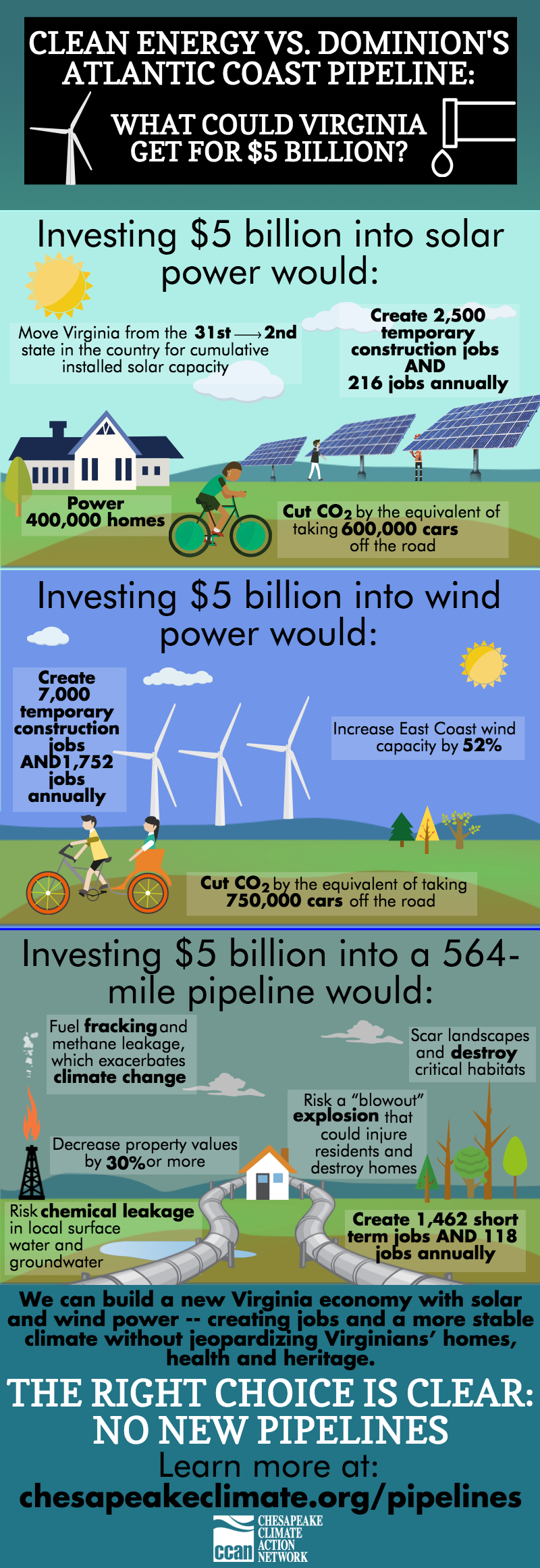
Click here to share on Facebook
Click here to share on Twitter
Sources:
1. “Lazard’s Levelized Cost of Energy Analysis – Version 8.0.” Lazard. Sep. 2014. <http://gallery.mailchimp.com/ce17780900c3d223633ecfa59/files/Lazard_Levelized_Cost_of_Energy_v7.0.1.pdf> Slide 11 estimates that the capital cost of utility-scale solar PV is $1,500/kilowatt.
2. U.S. Energy Information Administration. “2013 Average Monthly Bill- Residential.” 2014, <http://www.eia.gov/electricity/sales_revenue_price/pdf/table5_a.pdf> Based on capital costs assumptions, and a median 20.3% capacity factor, we assume a solar output of 5,631,220 megawatt-hours. The average monthly electricity usage in Virginia is 1,156 kilowatt-hours.
3. National Renewable Energy Laboratory. “About JEDI Photovoltaics Model.” N.p., n.d. Web. 13 Oct. 2015. <http://www.nrel.gov/analysis/jedi/about_jedi_pv.html>. Calculated using the National Renewable Energy Laboratory’s Jobs and Economic Development Indicator (JEDI) “Scenario_PV_Model_rel._PVS3.24.14”
4. “Lazard’s Levelized Cost of Energy Analysis – Version 8.0.” Lazard. Sep. 2014. <http://gallery.mailchimp.com/ce17780900c3d223633ecfa59/files/Lazard_Levelized_Cost_of_Energy_v7.0.1.pdf> Slide 11’s high estimate of the capital cost of wind energy is $1,800/kilowatt.
5. U.S. Energy Information Administration. “2013 Average Monthly Bill- Residential.” 2014, <http://www.eia.gov/electricity/sales_revenue_price/pdf/table5_a.pdf> Based on capital costs assumptions, and a 30% capacity factor, we assume a solar output of 6,935,000 megawatt-hours. The average monthly electricity usage in Virginia is 1,156 kilowatt-hours.
6. National Renewable Energy Laboratory. “About JEDI Photovoltaics Model.” N.p., n.d. Web. 13 Oct. 2015. <http://www.nrel.gov/analysis/jedi/about_jedi_pv.html>. Calculated using the National Renewable Energy Laboratory’s Jobs and Economic Development Indicator (JEDI) “Land-based Wind Model rel. W07.08.15”
7. Lucas, Kevin. EmPOWER and RPS Progress Update. Maryland Energy Administration, 21 May 2015. <http://www.mde.state.md.us/programs/Marylander/Documents/MWGHandout3MEA05212015.pdf>. Slide 15 estimates, based on the EPA 111(d) Base Case analysis that “PJM” — the electricity grid region in which Virginia is located — will have a carbon intensity of 1,124 lbs per megawatt-hour.
8. U.S. Environmental Protection Agency. “GHG Equivalencies Calculator – Calculations and References.” N.p., n.d. Web. <http://www2.epa.gov/energy/ghg-equivalencies-calculator-calculations-and-references#vehicles>

